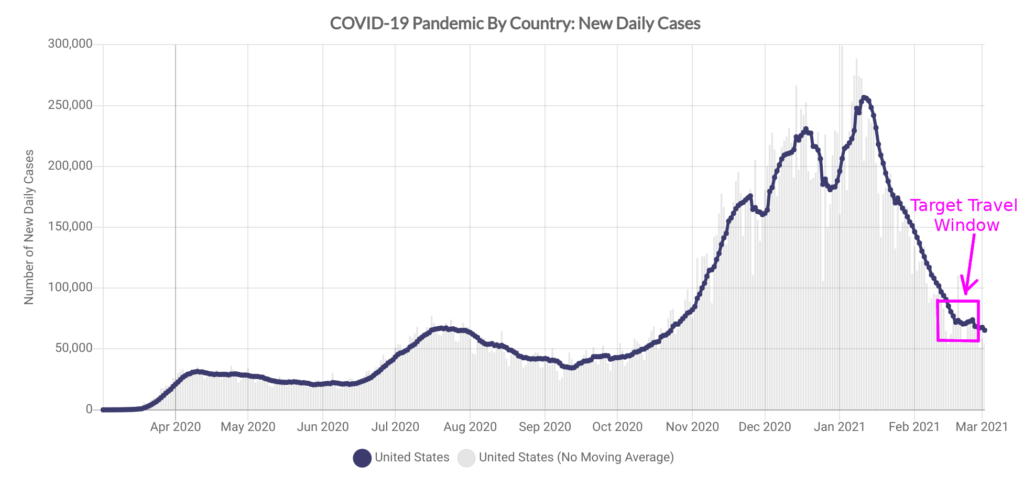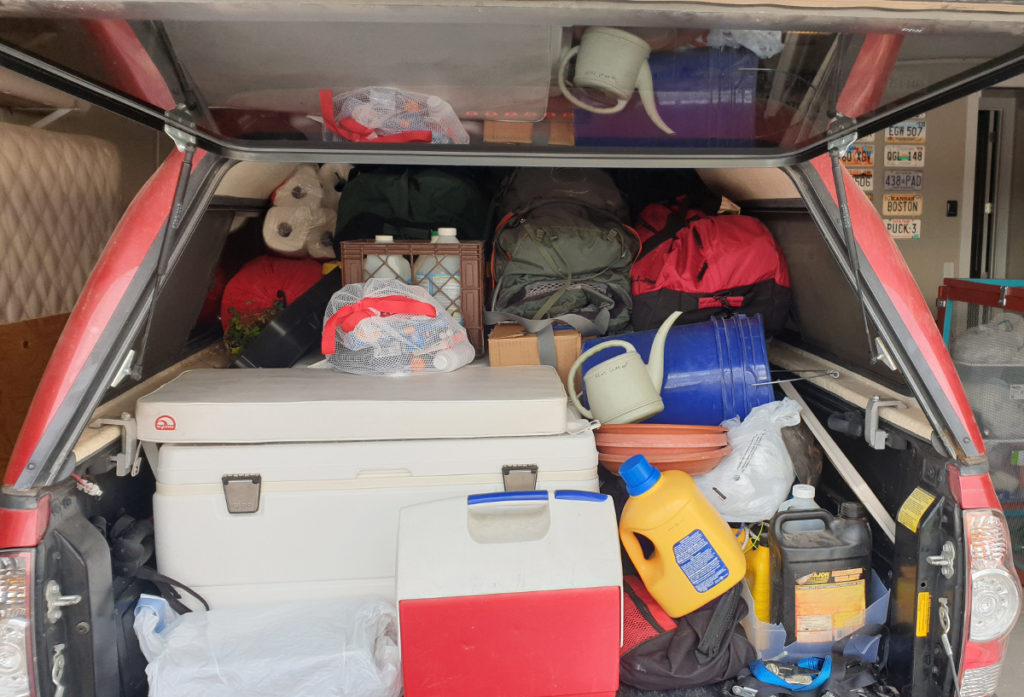After a year living with restrictions from the COVID-19 pandemic, we’re all wondering when it will be safe to travel again. While I certainly don’t expect to be hopping on an airplane any time soon, I’m growing cautiously optimistic that we’ll be able to safely resume road trips in the not-too-distant future. In the meantime, it is still possible to take a road trip. However, I can’t say I recommend it at this point unless it’s some kind of emergency.
You may have noticed that I’ve been absent from posting on here the past few weeks. The reason is because I have been on an odyssey of a road trip across the United States. I am now in mandatory quarantine at my final destination and will be publishing a series of posts over the next several weeks about what taking a road trip across the United States in the middle of both the winter and a once in a century pandemic was like.
Am I Crazy? Why the Hell Am I Traveling?
Before diving in, I want to emphasize that this trip is not a vacation or a holiday. The decision to travel was not an easy one, and the trip took months of planning to pull off safely and successfully. In the end, it boiled down to a couple of reasons.
- The primary purpose of the road trip is to be with my family and help them through the rest of the pandemic. My mom and dad both fall into the higher risk category for COVID-19. Any way I can help them with things like running errands and grocery shopping is that much less they have to worry about.
- Despite the fact that I don’t touch politics with a 10-foot pole and consider myself an apolitical person, I have received numerous threats of politically-motivated violence in Arizona going back to last summer. It’s only been getting worse over the past few months. Many of my family and friends have been legitimately concerned about my safety.
The Bubble: Your Secret to a Safe COVID-19 Road Trip
The bubble didn’t become a mainstream part of the COVID-19 vocabulary until the NBA and the NHL resumed their seasons last summer. Both leagues wanted to establish a COVID-free environment that was isolated from the outside world to safely conduct their playoffs.
The two leagues used a slightly different strategy to establish their bubbles. The NBA brought all of its teams into a single bubble in Orlando, Florida. On the other hand, the NHL used two bubbles. Western Conference teams went into a bubble in Edmonton, Alberta, while Eastern Conference teams established a bubble in Toronto, Ontario. Using rigorous testing and strict entry and exit protocols, neither league reported a single COVID-19 case the entire two-plus months they were in the bubble.
General Bubble Strategy
You can establish a bubble for any reason. In fact, I highly recommend it to stay safe during the pandemic. All bubbles should follow the same basic rules.
- Establish a strict and specific protocol for how people must safely enter and exit the bubble.
- You can put as many or as few people in the bubble as you wish. However, I recommend minimizing the number of people in your bubble.
- Don’t go in and out of the bubble. Once you’re in the bubble, plan to stay there for the duration.
My General Bubble Strategy for Road Trips
We’ll go into details shortly, but I tried to keep my general road trip bubble strategy simple.
- Stay completely isolated except for when I stay with people I highly trust
- Establish a “clean” zone in the house and truck. Nothing enters that zone without being sanitized and/or quarantined first.
- Keep all “contaminated” items in a designated, sealed off area. Anything that enters from or has contact with the outside world without being sanitized or quarantined is considered “contaminated”
The Bubble is not Foolproof
No matter how well you think you’ve set up your bubble, it is not 100% foolproof. Every bubble has its weak spots and vulnerabilities. You can rest assured that the virus can and will exploit those vulnerabilities. The better you understand those liabilities, the better you will be able to protect yourself.
So what do weak spots in your bubble look like? Consider the NBA and the NHL bubbles last summer. What do you think possible vulnerabilities could be?
- Workers and caterers bringing food in and out of the bubble.
- Hotel cleaning crews sometimes came in from outside the bubble.
How about a travel bubble? On my road trip, the primary weak spot was stopping at gas stations. The risk of contracting COVID-19 from the pumps themselves is low. However, there is plenty of opportunity to come in contact with people who could have come from anywhere.
Rules and Protocols to Stay Safe in Your Road Trip Bubble
Once you identify weak points in your bubble, implement rules to safeguard against those vulnerabilities. What rules would you implement to protect against the fueling vulnerabilities in my bubble? Here’s what I did.
- Fuel up in quiet, rural areas away from the freeway.
- Use gas stations that have plenty of spacing between pumps.
- Wear N-95 masks at all times when outside the truck cab’s “clean” zone.
- Disinfect high-touch surfaces such as the steering wheel, turn signals, and door handles after every stop.
- Sanitize hands and wash them with soap and water for 20 seconds after every stop. Carry soap and water so you don’t have to enter public restrooms.
- Do not touch anything outside the truck cab without gloves on
Not surprisingly, those are far from the only rules we need to implement to stay safe on the trip.
Timing
The timing of the trip is the trickiest, but most crucial aspect to get right. You want to time your trip for when COVID-19 case loads are as low as possible. Factor in complications from snow and ice and it’s like trying to pee through a Cheerio at ten paces. Thankfully, all of the necessary tools are readily available.
As far back as last October, nearly all of the COVID-19 modeling showed new cases in the US peaking in early-to-mid January. Based on patterns from the spring and summer waves, I knew that the best window to travel would likely be 4 to 6 weeks after the peak. Any longer than that and you risk case loads starting to increase again. So how’d we do?

Not perfect, but pretty good given the circumstances.
Driving and Stopping Protocols
- No Toll Roads. The idea here is to avoid contact with toll takers, not save money. Cashless tolls are okay.
- Do not enter any building under any circumstance, except for my friend’s house that I’m staying at or for a serious medical emergency.
- The truck cab is a “clean” zone. No foreign or outside objects are to enter the truck cab.
- A separate, sealed area shall be established in the truck bed to hold “contaminated” items.
- Do not stop other than to get gas, use the restroom, or sleep.
- Nobody other than myself shall enter the truck cab.
Gear to Pack
Because we’re not going into any buildings or public areas, we must carry everything we need to survive. Pack like you’re venturing deep into the backcountry for several weeks. This includes, but is not limited to:
- Food and water. Canned goods are your best friend.
- Blankets and pillows. Be sure you can stay warm during colder months. I had to sleep in the truck in an ice storm in Kentucky.
- Survival Gear. What you pack depends on whether you’ll be dealing with extreme cold or extreme heat, but be sure you can survive if you get stranded somewhere.
- Solar panels. If you get stranded, being able to charge your phone can be the difference between life and death.
- Tools and gear to get your car out if you get stuck. At a bare minimum, I carry saws, a tow strap, and a jumper box.

Pre-Departure
- Self-isolate at home for 2 weeks prior to departure
- All shopping, vehicle maintenance, etc. must be completed prior to entering the bubble
Road Trip Route
- Optimize your route so you’re traveling through as few states as possible while still minimizing travel times.
- Stay out of states without statewide mask mandates
- Avoid states that have high COVID-19 case loads and/or few restrictions.
- Try to stay south so you don’t run into snow, ice, or other winter weather.
Post-Arrival
- Quarantine for 10 days upon arrival as required by state law.
- I recommend self-quarantining at your destination even if there is no mandatory quarantine.
Crossing State Lines
One thing about this whole pandemic that is equally as fascinating as it is head scratching is just how much rules and restrictions vary from state-to-state. What is perfectly okay in one state might get you excoriated in the next.
As a result, I find it easier to treat it like you’re crossing different countries instead of different states. I have found that states fall into one of two categories. They either take the pandemic seriously or they mock it and go out of their way to flout the rules. Regardless of whether or not you agree with them, please obey all state laws and restrictions. They’re in place for a reason.
What’s Next
Next up is the first leg of the trip from Arizona to Oklahoma. Along the way, I run into an unexpected foe – the Polar Vortex – and drive right into some of the most wild weather I’ve ever seen on a trip. Make sure you tune in next week.
Top Photo: Feeling Lucky on my other Covid Road Trip
Las Vegas, Nevada – July, 2020
Pingback:COVID-19 Road Trip Journal: Wild Weather in the Wild West
Pingback:Exclusive Endeavor: A Compelling Lesson in COVID-19 Numerical Modeling